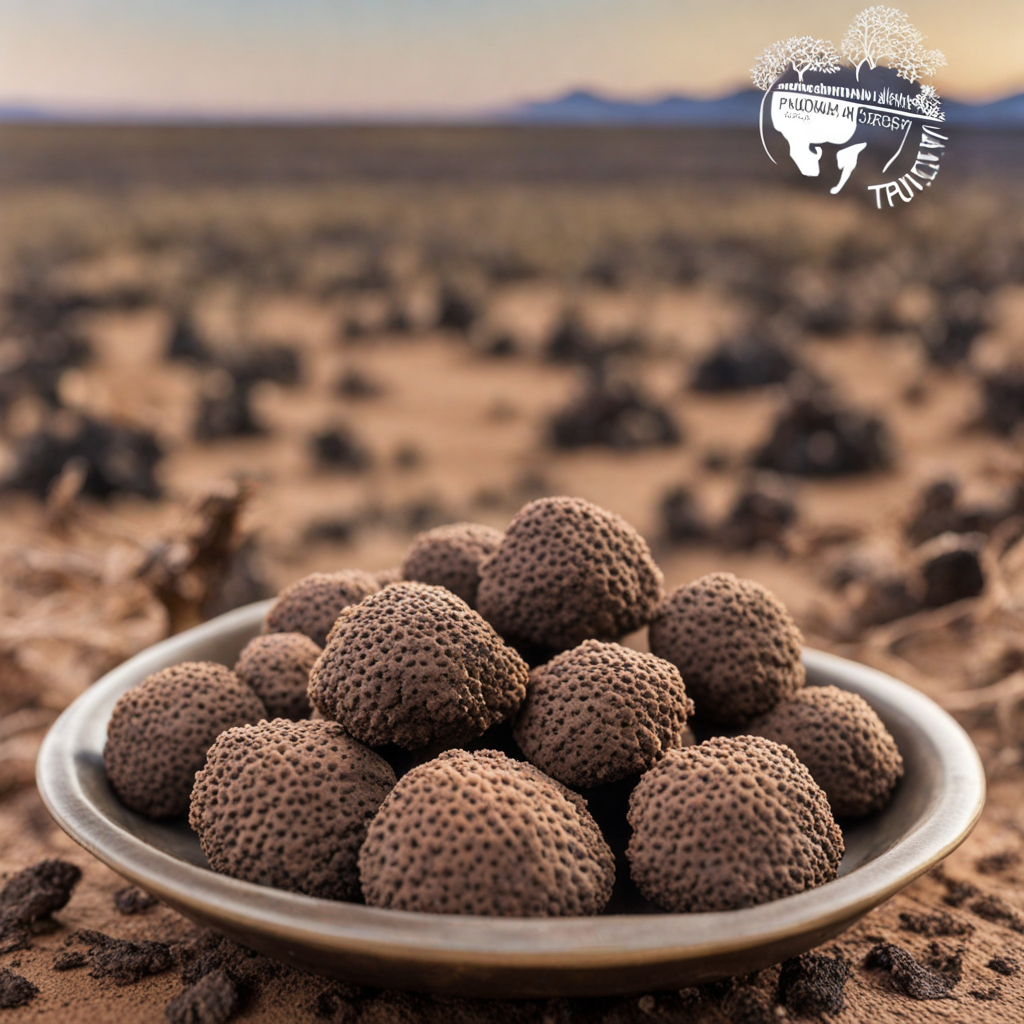Kalahari Truffles
Kalahari Truffles, also known as the "desert truffle," are a unique and exquisite delicacy found in the arid landscapes of Namibia. These underground fungi thrive in symbiosis with the roots of certain trees, particularly the acacia, and are typically harvested during the rainy season. Their earthy aroma and nutty flavor profile make them a sought-after ingredient for culinary enthusiasts and chefs looking to elevate their dishes. The truffles are often described as having a more subtle and refined taste compared to their European counterparts, making them a versatile addition to various recipes. The texture of Kalahari Truffles is somewhat similar to that of a potato, with a firm yet creamy interior that melts in your mouth. When cooked, they can be used in a variety of ways—sautéed, grated, or even served raw in salads. Their unique flavor pairs beautifully with a range of ingredients, from rich meats to fresh vegetables, and they can also enhance the taste of creamy sauces and risottos. The culinary possibilities are boundless, as these truffles can be incorporated into both traditional Namibian dishes and modern fusion cuisine. Harvesting Kalahari Truffles is a labor-intensive process, often involving skilled foragers who rely on the scent of the truffles and the help of trained dogs or pigs to locate them beneath the arid soil. This makes them not only a rare find but also a special treat that reflects the rich gastronomic heritage of Namibia. As you explore the flavors of Kalahari Truffles, you'll discover a taste of the desert that is both exotic and deeply rooted in the local culture, providing a delightful adventure for your palate.
How It Became This Dish
The History of Kalahari Truffles: A Culinary Treasure of Namibia #### Origin and Discovery Kalahari truffles, known scientifically as *Tuber spp.*, are a unique and prized delicacy found in the semi-arid regions of southern Africa, particularly in the Kalahari Desert of Namibia. These subterranean fungi thrive in sandy soils and are closely associated with specific host plants, such as various species of acacia. The truffles’ life cycle begins with the germination of spores that form a symbiotic relationship with the roots of these plants. While they remain hidden underground for most of their life, Kalahari truffles reveal themselves after the first rains of the season, typically between January and March, when they swell and push through the soil. The indigenous San people, also known as Bushmen, are believed to be the first to discover and utilize Kalahari truffles. Their deep understanding of the land and its resources enabled them to locate these hidden treasures, which became an integral part of their diet. For centuries, the San have relied on the truffles not only for sustenance but also as a food source during times of scarcity, showcasing their resilience and adaptability to the harsh desert environment. #### Cultural Significance Kalahari truffles hold significant cultural importance for the San people and other local communities. They are not only a food source but also play a role in social and cultural practices. For the San, gathering truffles is often a communal activity, fostering cooperation and sharing among families and clans. The truffles are typically harvested by women and children, who possess the knowledge of the best locations and techniques for unearthing these delicacies. Traditionally, Kalahari truffles were consumed fresh or dried for later use. The dried truffles can be ground into flour and used in various dishes, enhancing the nutritional value of meals. They hold a unique flavor, often described as earthy and nutty, reminiscent of the forest floor. The versatility of Kalahari truffles has allowed them to be incorporated into various culinary traditions among local communities, where they are often enjoyed in stews, soups, or simply roasted over an open fire. Moreover, the truffles are sometimes used in traditional medicinal practices. The San and other indigenous groups have long believed in the healing properties of various plants and fungi, and Kalahari truffles are no exception. They are thought to possess nourishing qualities that can boost vitality and overall health, making them a cherished component of the traditional pharmacopoeia. #### Development Over Time As Namibia's colonial history unfolded in the late 19th and early 20th centuries, the perception and use of Kalahari truffles began to evolve. European settlers, intrigued by the local cuisine and its ingredients, started to take notice of the truffles. However, the cultural significance of the truffles often went unrecognized or undervalued by colonial authorities, who were more focused on exploiting the land and its resources. In the decades following independence in 1990, there has been a renewed interest in indigenous foods and their cultural significance. The revival of traditional practices and the promotion of local cuisine have led to a greater appreciation for Kalahari truffles. Chefs and food enthusiasts have begun to explore the culinary potential of these truffles, integrating them into contemporary dishes that celebrate Namibia's rich culinary heritage. Today, Kalahari truffles are increasingly recognized beyond local communities. They have gained attention in the global culinary scene, where they are celebrated for their unique flavor and rarity. Gourmet restaurants in Namibia and beyond have started to feature Kalahari truffles on their menus, often pairing them with other local ingredients to create innovative dishes. This has helped to elevate the truffle's status from a traditional food source to a sought-after delicacy. #### Sustainable Harvesting and Economic Impact As interest in Kalahari truffles has grown, so too have concerns about sustainability and the impact of commercial harvesting. The San people, who have traditionally gathered truffles for generations, are now facing challenges from external pressures, including overharvesting and land degradation. To address these issues, various conservation efforts have been initiated, emphasizing the importance of sustainable harvesting practices that respect the delicate ecosystems where truffles thrive. Community-based initiatives have also emerged, allowing local populations to benefit economically from the truffle trade while preserving their cultural heritage. By promoting sustainable harvesting and fair trade practices, these initiatives aim to empower the San people and ensure that they retain control over their traditional knowledge and resources. #### Modern Culinary Scene The integration of Kalahari truffles into the modern culinary scene has opened new avenues for chefs and food lovers alike. They have become a symbol of Namibian gastronomy, inspiring a wave of culinary innovation that highlights local ingredients and traditional cooking methods. Chefs often seek to celebrate the unique flavors of Kalahari truffles by pairing them with artisanal cheeses, fresh herbs, and locally sourced meats. Furthermore, food festivals and culinary events in Namibia increasingly showcase Kalahari truffles, drawing attention to their role in the nation's culinary identity. These events not only promote local cuisine but also encourage dialogue about food sovereignty, sustainability, and the importance of preserving indigenous food systems. #### Conclusion Kalahari truffles are more than just a culinary delight; they embody a rich history and cultural significance that connects the land, its people, and their traditions. From their origins among the San people to their modern-day recognition in global cuisine, Kalahari truffles have navigated a complex journey of appreciation and adaptation. As the world continues to embrace the concept of sustainable food practices, the story of Kalahari truffles serves as a reminder of the importance of respecting indigenous knowledge and fostering a deeper understanding of the cultural heritage that shapes our culinary landscape. The future of Kalahari truffles lies in the hands of those who honor their past while paving the way for sustainable and equitable practices that benefit both local communities and the environment. In celebrating Kalahari truffles, we also celebrate the resilience of a people and a planet that continue to thrive against all odds.
You may like
Discover local flavors from Namibia







